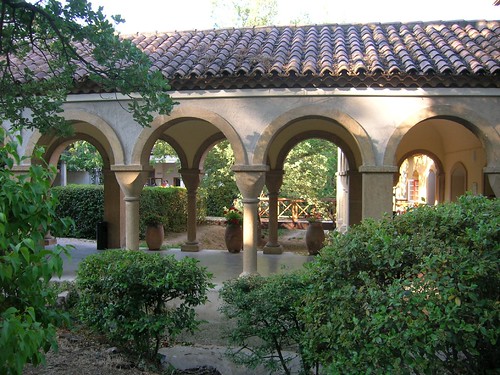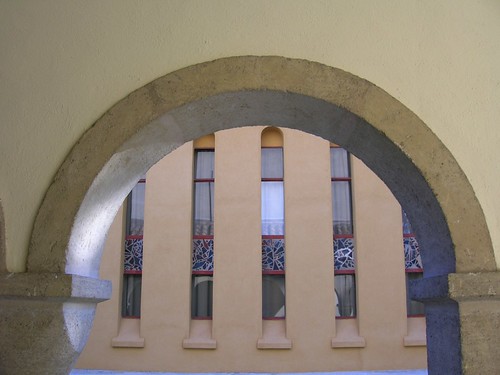Yesterday was a quite super active day in the bay area with a serie of meeting at PARC and a dinner with friends in SF.
Located in Palo Alto, PARC is a subsidiary of Xerox Corporation, conducts pioneering interdisciplinary research in the physical, computational, and social sciences.
It first started with a meeting with Elizabeth Churchill and Les Nelson to whom I presented my PhD research and get some more insights about they're up to. Some comments from Elizabeth:
It seems that the automatic location-awareness tool in catchbob could be problematic because there is no context around it. Since the users in this experimental condition did not exchange lots of messages (mostly only about their proximity to the object via signal strength indications), there is a lack of a social context that could be helpful to interprete the locational data. As opposed to the players in the "with the location-awareness" who better discussed the strategy and then had a context to help them doing inferences about the others' location (they indicated through map annotations).
She pointed me at this kind of overtrust on technology (the location-awareness tool): since it's an available information, they pay attention to it.
An additional remark concerns the fact that coordination information liek this location-awareness is more than coordination: it's establishing a common ground of the situation, by wrapping up these information into a strategy context.
She encouraged me to ask players some questions about the way they experienced collaboration: did you feel like you were wandering alone? or being part of a team? so that I can evaluated the level of involvement in a social context.
Les asked me whether there could be a kinf of optimal strategy index that would be helpful to measure the spatial behavior.
I then had a meeting with Nicolas Ducheneaut who explained me how he ended up there doing research about multi-user applications (and how PARC works in terms of project management). One of Nicolas' project is the super neat project about World of Warcraft called "Play On".
He showed me some of the ongoing things they are doing, mainly the "social dashboard" they patented. They actually isolated important factors in terms of guild management in WoW (such as guild size...), those who are important so that players keep enjoying the game and then developed some services and tools that would be helpful for that matter (for game community managers!): for instance seeing the evolution of certain parameters, the fact that some high-value players left a guild, the desagregation of guilds, the isolation of rotten classes... I told him that I would be very interested in seeing this also feeded back to the players (and not only the guild manager), like in our virtual mirror project at the lab (giving the group an image of itself to modify the way they collaborate). Thus, they're basically focusing on improving the social aspects of the game (so that players keep playing!) through certain kinds of services. Of course, this is of interests to game editors (even though the content and the gameplay are still tremendously an important feature, there should be also an emphasis on those social aspects; and those tools they develop are helfpul).
He also worked on an relevant project about "social tv" that might be interesting for private research projects.
Regarding my PhD research, he made some insightfuls comments and connections with others' work:
It started to make him think at Aoki, P. M.; Woodruff, A. Making space for stories: ambiguity in the design of personal communication systems. ACM Conference on Human Factors in Computing Systems (CHI 2005); 2005 April 2-7; Portland, OR. NY: ACM; 2005; 181-190.
Then he pointed me on another paper: Dabbish L. & Kraut R. (2004) Controlling interruptions: Awareness displays and social motivation for coordination, in: Proceedings of the ACM Conference on Computer Supported Cooperative Work (CSCW'04), New York: ACM Press, 182-191
I'll explore these papers in the near future.
For him, the information about others' whereabouts in space can ruduce the richness of the mental map people build of space by just focusing on a certain kind of information (conveyed by the location-awareness tool) and not the others (cf Kevin Lynch, image of the city, p45): players who had the "follower" role maybe had a poor representation, whereas the "explorer" had a richer image of space. I am wondering whether I can apprehend this sort of things with the data I have (given that participants knew the campus). Maybe some studies about ethology or animal behavior in space could be valuable for that mattter.
The final round at PARC was with Victoria Bellotti, to whom I also described my PhD research. Here are some comments she made:
Did the explorers were more successful in terms of performance? did they make more spatial modeling mistakes?
She was concerned by the location accuracy + lag and thought that 15meters would be a problem for this sort of task (not to mention the variability of this accuracy in different places due to the hotspots repartition). In her opinion, people were perhaps relying too much on the location-awareness tool: if the accuracy is 15 meters and if there is a 3 seconds lag, users might be misleaded. I would answer that for our task, and givent the EPFL campus, the 15meters accuracy is not that much of a problem, since it's approximately the size of roomsm and it discriminated different zones with different boundaries (and no line of sight).
She thinks that indeed, more communication can lead to more grounding of the situation, which would be why the richness of communication in the no awareness tool condition had positive on the mutual modeling index.
Also, I have to be careful when referring to the condition "without AT" because it's not really without but without explicit AT because they can dialogue but indeed it's not a awareness tool strictly speaking.
Of course, she pointed me at the dangers of this sort of field experiment study, arguing that results are bound to the system and the context I tested (which I am definitely aware of). Results are then bound to the system configuration: location accuracy, area size, number of users... The nature of the task is also important too, it puts demands and constraints arbitrarily on the context, And she's then wondering how far these results could be generalized.
I am deeply aware of all these comments (right from the beginning of the project actually, when choosing a more quantitative methodology but mixed with qualitative data). And my point is simple: my study is rather here to counterbalance the frenziness and overemphasis of location-awareness technologies. IMO It's rather here to ponder the engineerical madness around those applications that are oooh so neat like the intelligent fridge (!).
Thanks all for these inputs, they're invaluable for the evolution of the PhD project.
I finally had lunch in SF with my finnish friends Jyri Engeström and Ulla-Maaria Mutanen who nicely introduced me to Elizabeth Goodman and Mike Kuniavsky. The discussion was there around various topic but mainly about bottom-up innovation and independent structures a la Squid Labs and others. Europe is especially in the need of this kind of places/structure with crazy folks doing project. Ulla-Maaria was referring to crafting stuff but to me, even peopel doing user experience or more abstract research matter to. These structures (or non-structures) are act as the Research and Development of tomorrow's services, product and memes.
Liz also talked about how the relationship between engineers and interaction designers/user experience specialists should be more a conversation about users' context than just getting a set of requirements.
I was interested by Mike's perspective on user experience of pervasive computing , which is what is going to address in his next book.












